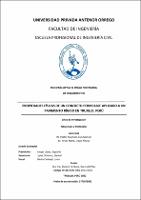Mostrar el registro sencillo del ítem
Propiedades físicas de un concreto permeable aplicado a un pavimento rígido en Trujillo, Perú
| dc.contributor.advisor | Durand Orellana, Rocío del Pilar | |
| dc.contributor.author | Pastor Huamaní, Luis Manuel | |
| dc.contributor.author | Reyes Narro, Diego Alonso | |
| dc.creator | Pastor Huamaní, Luis Manuel | |
| dc.date.accessioned | 2022-07-25T23:45:37Z | |
| dc.date.available | 2022-07-25T23:45:37Z | |
| dc.date.issued | 2022 | |
| dc.identifier.uri | https://hdl.handle.net/20.500.12759/9216 | |
| dc.description.abstract | En esta investigación se realizó el estudio de diferentes mezclas de un concreto permeable con la finalidad de aplicarse en un pavimento rígido en la ciudad de Trujillo, Perú. Para lograr esto, se realizó los ensayos de laboratorio respectivos a los materiales requeridos. Desde el material extraído (agregados) de la cantera “Quebrada el León” hasta los ensayos de laboratorio propios del concreto permeable. Una vez realizadas las pruebas respectivas a los agregados, se realizó el diseño de mezcla tanto del concreto patrón (concreto convencional con una resistencia de diseño f’c = 280 kg/cm2 ), como del concreto permeable, utilizando la metodología del ACI 211.1 y del ACI 522R-10 respectivamente. Una vez realizado el diseño de mezcla, se sometió el concreto patrón y las diferentes mezclas de concreto permeable a los diferentes ensayos, sabiendo que un pavimento rígido trabaja a flexión, se sometieron a las pruebas de resistencia a la flexión (con carga a los tercios). Para finalizar esta investigación, se dan a conocer y se discuten los resultados obtenidos de tal manera de señalar si este tipo de concreto es apto y conveniente para poder aplicarlo en un pavimento rígido. Realizada esta investigación concluimos que, al analizar los resultados, se aprecia que el porcentaje de vacíos influye en la resistencia a la compresión, resistencia a la flexión y permeabilidad de un concreto permeable. Mientras más porcentaje de vacíos tenga este concreto, menor será su resistencia, tanto a la compresión como a la flexión y mayor será su índice de permeabilidad. Teniendo como referencia investigaciones anteriores en los antecedentes, se nos dio a conocer que el concreto permeable posee una baja resistencia a la compresión y flexión, debido a esto decidimos utilizar el aditivo SIKACEM plastificante con finalidad de alcanzar la resistencia deseada. Una vez realizado los ensayos observamos que la mezcla de concreto permeable 2, alcanzo y supero la resistencia mínima establecida en la norma (ce.010 Pavimentos Urbanos). | es_PE |
| dc.description.abstract | In this research, the study of different mixtures of a permeable concrete was carried out with the purpose of being applied in a rigid pavement in the city of Trujillo, Peru. To achieve this, the respective laboratory tests were carried out on the required materials. From the material extracted (aggregates) from the ““Quebrada el León““ quarry to the laboratory tests of the permeable concrete. Once the respective tests were performed on the aggregates, the mix design of both the standard concrete (conventional concrete with a design strength f'c = 280 kg/cm2) and the pervious concrete was carried out, using the methodology of ACI 211.1 and ACI 522R-10, respectively. Once the mix design was carried out, the standard concrete and the different pervious concrete mixes were subjected to the different tests, knowing that a rigid pavement works in flexure, they were subjected to flexural strength tests (with load to the thirds). To conclude this research, the results obtained are presented and discussed in order to indicate if this type of concrete is suitable and convenient to be applied in a rigid pavement. After this research, we conclude that, when analyzing the results, it can be seen that the percentage of voids influences the compressive strength, flexural strength and permeability of a permeable concrete. The higher the percentage of voids in this concrete, the lower its compressive and flexural strength and the higher its permeability index. Having as reference previous research in the background, we learned that permeable concrete has a low compressive and flexural strength, so we decided to use the plasticizing SIKACEM admixture in order to achieve the desired strength. Once the tests were carried out, we observed that the mixture of pervious concrete 2, reached and surpassed the minimum resistance established in the norm (ce.010 Urban Pavements). | en_US |
| dc.description.uri | Tesis | es_PE |
| dc.format | application/pdf | es_PE |
| dc.language.iso | spa | es_PE |
| dc.publisher | Universidad Privada Antenor Orrego | es_PE |
| dc.relation.ispartofseries | T_CIVIL_2089 | |
| dc.rights | info:eu-repo/semantics/openAccess | es_PE |
| dc.rights.uri | https://creativecommons.org/licenses/by/4.0/ | es_PE |
| dc.source | Universidad Privada Antenor Orrego | es_PE |
| dc.source | Repositorio Institucional - UPAO | es_PE |
| dc.subject | Concreto | es_PE |
| dc.subject | Permeable | es_PE |
| dc.title | Propiedades físicas de un concreto permeable aplicado a un pavimento rígido en Trujillo, Perú | es_PE |
| dc.type | info:eu-repo/semantics/bachelorThesis | es_PE |
| thesis.degree.level | Título Profesional | es_PE |
| thesis.degree.grantor | Universidad Privada Antenor Orrego. Facultad de Ingeniería | es_PE |
| thesis.degree.name | Ingeniero Civil | es_PE |
| thesis.degree.discipline | Ingeniería Civil | es_PE |
| dc.subject.ocde | https://purl.org/pe-repo/ocde/ford#2.01.00 | es_PE |
| renati.advisor.orcid | https://orcid.org/0000-0002-6592-6520 | es_PE |
| renati.author.dni | 70364261 | |
| renati.author.dni | 72809252 | |
| renati.advisor.dni | 18186640 | |
| renati.type | https://purl.org/pe-repo/renati/type#tesis | es_PE |
| renati.level | https://purl.org/pe-repo/renati/level#tituloProfesional | es_PE |
| renati.discipline | 732016 | es_PE |
| renati.juror | Vargas López, Segundo | |
| renati.juror | Lopez Otiniano, Stewart | |
| renati.juror | Media Carbajal, Lucio | |
| dc.publisher.country | PE | es_PE |
Ficheros en el ítem
Este ítem aparece en la(s) siguiente(s) colección(es)
-
Ingeniería Civil [1260]


